Filmed October 1966
My next outing on THE FBI, THE RAID, was one of my lesser productions for the series, but I want to include it for a special reason, which will be revealed later.
The scripts for the series were allegedly inspired by FBI cases from the Bureau’s files, but I didn’t think the current show had that origination. It was based on a dangerous FBI action, a raid. Three of our seven days were scheduled for location and it proved to be a complex and difficult location to find. We had to have a motor hotel with a courtyard and a rooftop. Across the street we needed a real estate office. We also needed another rooftop in the vicinity for scenes involving the rooftop at the motel. Finally we would need a site nearby where the killing in the opening teaser could be committed. Now Los Angeles is a very large city — that shouldn’t have been difficult to find –- right? Wrong! After days of location scouting we finally found a large apartment building with the requisite courtyard and rooftop that would serve as our motor hotel and there was a small office building across the street; it wasn’t real estate, but a sign could fix that. However there was no other tall building in the area for our second rooftop. The Victory Drive-in Theatre nearby provided a very interesting alternative and also provided the site for the original killing. Our triangle was complete and with a bonus; I was going to be able visually to tie the three sites together. An added advantage: the substitute motel and office building were on a cul-de-sac that avoided the problem of automobile traffic.
Actually this was a caper film, but unlike the usual caper film that followed with meticulous detail the execution of a crime. This caper film focused its attention on the side of the law, the FBI, as it pursued the task of apprehending the criminals. But this time the agents were not in their offices, crime laboratories or out questioning people. They were just gray suited businessmen fading into the public as they planned their difficult mission.
We did not film all of the real estate building scenes at the location, only those at the entrance to the office. A set for the office was created at the studio where the ten pages that occurred there were filmed on the fourth day of the schedule.
This was the third and last time I would work with Ralph Meeker. The previous year he had guest starred in THE FBI episode, THE PLUNDERERS in which he played the leader of a gang of four involved in robbing banks. This time he was playing the leader of a gang of four involved in robbing banks.
If this show had been an episode of ROUTE 66, the interior scenes at the motel would have been shot in a suite at the location. But this was THE FBI and Richard Haman designed a motel suite on a soundstage at the studio where the nineteen and a half pages in the script were filmed much more effectively on the fifth, sixth and seventh days of the schedule.
I had wanted to work again with Nita Talbot ever since she played one of the prostitutes in the John Houseman production of THE ICEMAN COMETH. She had an interesting unusual personality and was a very fine actress.
The Victory drive-in was filmed at the end of the third day of production. The final sequence scheduled was of Rhodes and the other agent ascending the stairs in the interior of the building. But that day was a difficult day and completing that sequence would have resulted in very expensive overtime. We scratched the sequence from that day’s schedule and filmed it later back at the studio, using stairways in the soundstage.
The length of the script had been pared to fifty-one pages, a low page count by usual standards. The page count for the three location days was eighteen and two eighths pages, the usual expectation for filming on location. But this was far from the usual schedule. Let’s look at what I had to film on day three.
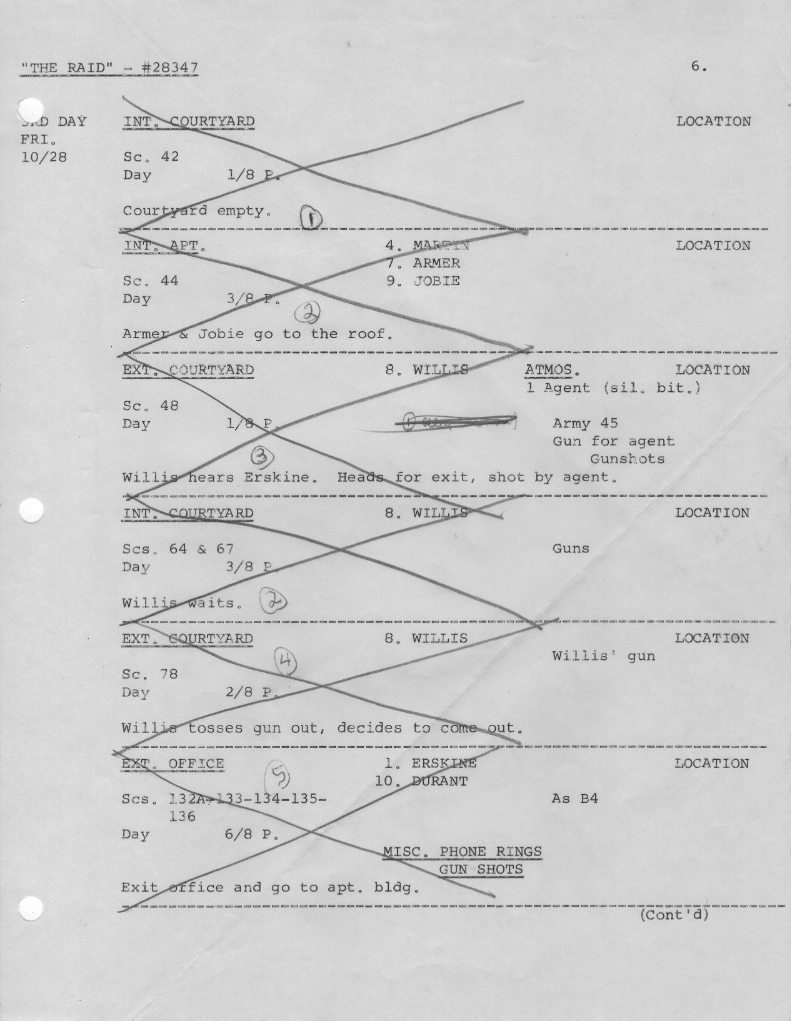
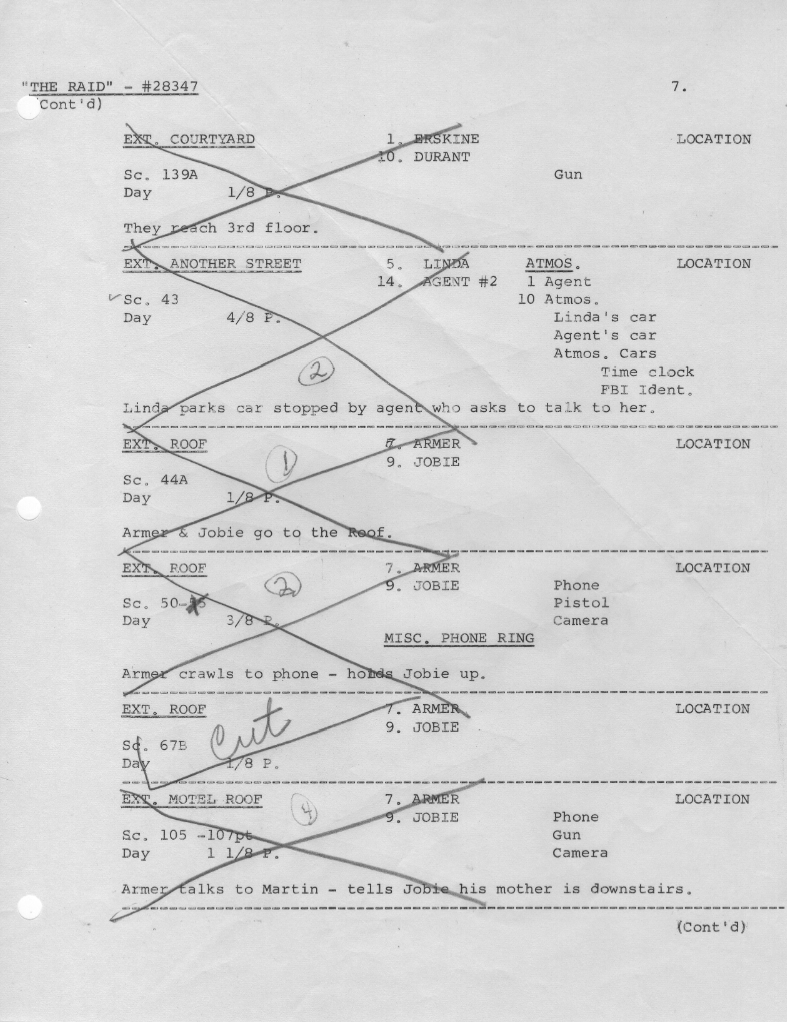
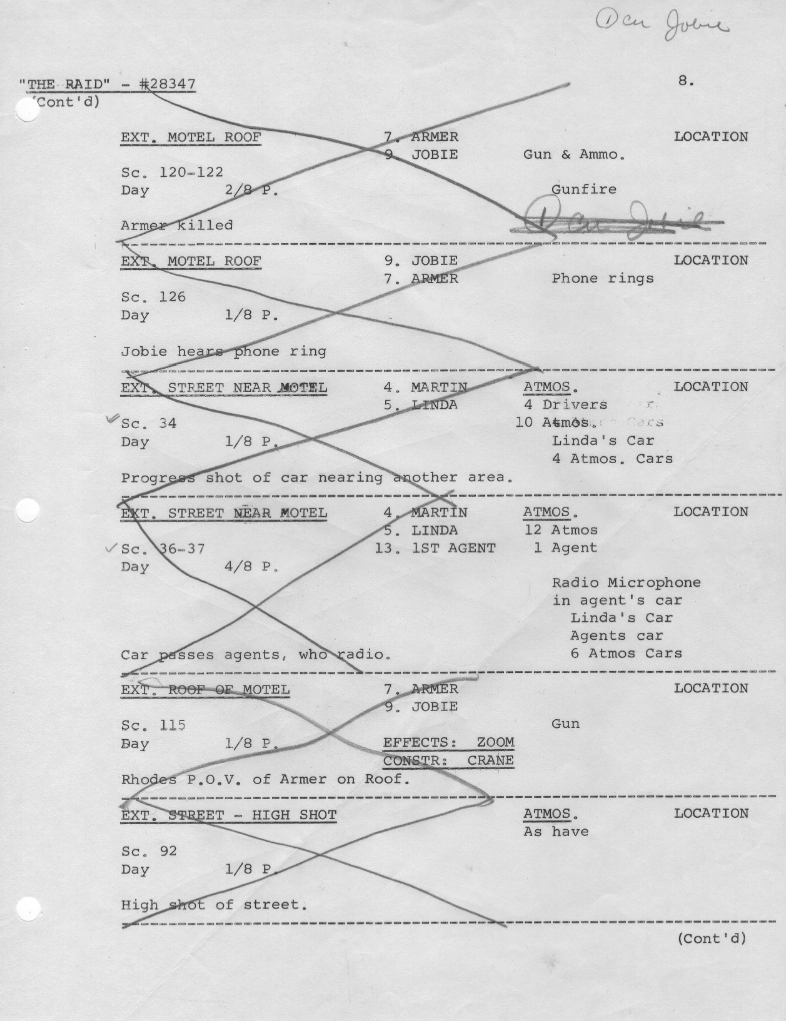
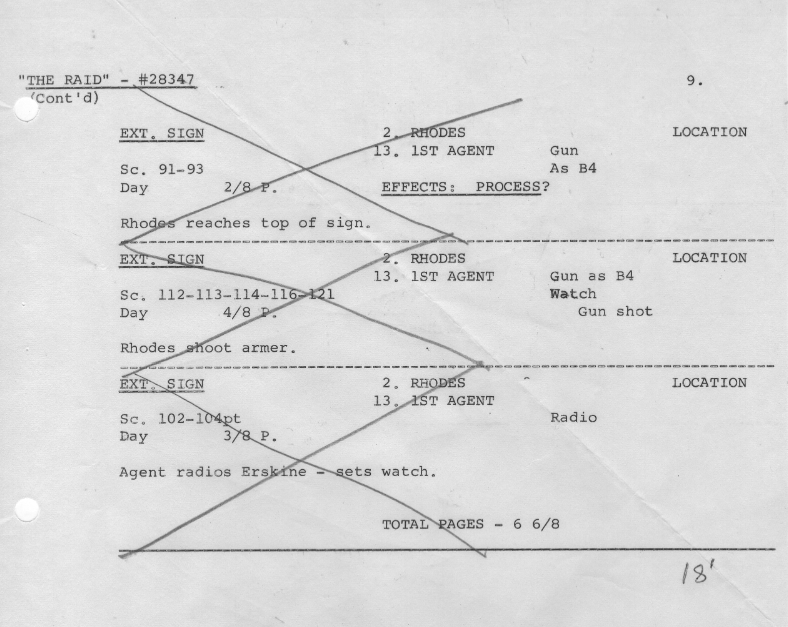
To begin with the page count for the day was heavier than either of the first two days and the action was spread over more areas of the location than on those days. Scenes were scheduled at the entrance to the real estate office, the front of the lodge, the courtyard, the roof of the lodge and the Victory drive-in. Dick Gallegly was out at the location early that Friday morning, assessing the situation. Dick suggested we bring in a second camera and he further suggested I pick out those setups that did not require sound and treat them as second unit. There were scenes in the inner courtyard with the wounded Shooter. That was where we decided to use the second camera. I would stage a shot with Shooter; Bill Cline, the cameraman, would light it and when it was ready, he and I would leave while Dick oversaw filming it. We would return to the front of the lodge where we did the same thing with the sequences requiring sound, but those shots I stayed to oversee the filming. We bounced back and forth that way the entire day. I was directing two units simultaneously, the cameraman was lighting two units.
George was portrayed by Rudy Solari, an actor I had met nine years before when I was casting a production of THE IMMORALIST at the Horseshoe Stage in Hollywood. I was having trouble finding an actor to play Bachir, the young Arab boy James Dean had portrayed in the Broadway production. Then Rudy came in. He solved my problem and, as it turned out, I solved his. At the time he had been working as a UPS driver, but had decided it was time to call it quits and leave Hollywood. THE IMMORALIST kept him in town, and once it opened to very good reviews I cast him (at the same theatre) in their next production of Robert Anderson’s ALL SUMMER LONG in the role John Kerr had played on Broadway. Rudy never left Hollywood. He had a fine career in both film and stage.
Late afternoon we moved over to the Victory Drive-in. We filmed the scenes on the ground of Rhodes and the agent running through, after which we prepared to film the two of them behind the Victory sign. We were losing the light but managed to complete the shots of them moving into position behind the O. That confined shot could be lit and as I remember, Cline also gave instructions to the lab to force the film when developing it. At the end of the third day we had completed all of our location work and were right on schedule.
After the filming had been completed and I had left the company, they must have realized that they had left ten-year old Jobie stranded up on the roof. A scene was written, filmed and inserted into the final sequence.
I did not direct that scene. I’m sure I would not have directed it to be performed that casually. They did not return to the to the location to film the scene. A set was constructed at the studio.
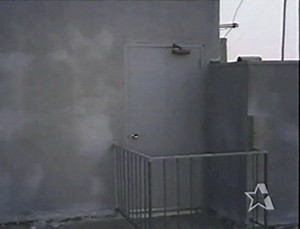
Roof at location
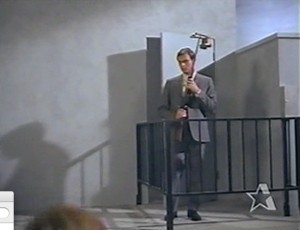
Roof set at studio
I had known Dick Gallegly, our production manager, from the time he was a second assistant director on DR. KILDARE. In a relatively short time he had worked his way through being a first assistant director, a location manager, and now a production manager.
At the end of the third day on location we had completed everything and were right on schedule. That was when Dick Gallegly thanked me and told me that Howard Alston, the executive production manager for QM Productions, had told him that if he couldn’t bring this show in on schedule, he would no longer be a production manager. Now Dick could have come to me earlier that morning and said, “You’ve got to get the rest of the scenes scheduled at this location today or I will lose my job.” But he didn’t. He had not put the pressure he was under onto me. DIck Gallegly was a class act.
The journey continues



Since the film on J Edgar Hoover just opened I wondered if her spoke with or wrote to you after any of the episodes?
No, I never heard from Mr. Hoover. My only contact with the Bureau was when they obviously checked me out before I was allowed to come aboard to direct. I obviously passed. I wonder if Clint will hear from him!
Ralph, there seems to be four images not being retrieved on this page (displayed as tiny boxes with ‘x’ in them). They’re between pages 6 and 7 of the schedule. Your old blog has the four schedule pages only, so I’m not sure if you were attempting to add something new to the current blog.
Also, I saw a video of Rudy Solari playing Monopoly with Joby in the apartment on your old blog, but not on the current one…not complaining, just an observation! Despite a long career, Rudy will always be Salish the ex-Medicine Man from ‘Star Trek’, first and foremost.
Regarding some of the other actors: Ken Lynch – is there a series he did NOT do?! Nita Talbot – if I recall correctly, she double-crossed Mickey Rooney in ‘The Fugitive’. John Milford – seeing him is like a flashing neon sign saying BAD GUY!
I have to agree with your assessment about this episode: a “lesser production.” Not your fault – you delivered the script as written, I assume. Nevertheless, I don’t think the FBI was painted in a good light…shooting up an apartment building from long distance in a running gun battle – P.U.!
I have a couple of jargon questions, thanks: First, when you say Bill Cline instructed the lab to “force” the film, what does that mean? Second, when you refer to Bill Cline as “cameraman”, is that shorthand for “cinematographer?” I assume “cameraman” is not the same as “camera operator.” Have there been cases where a cinematographer will do double duty and operate a camera, too? I’m guessing the operators have their own union and wouldn’t like that!
First off, I have checked and all of the videos are present. I am using Firefox as my server. I have checked using Safari as server and discovered that between the still inserts pages 6 and 7 there are four x’s, but nothing is missing. I will report this to my web designer to eliminate them. . Forcing the film was something I heard for the first time from Billy Spencer on THE ESCAPE on THE FBI. I’m not sure what it technically involved. Strictly something that would be done at the lab when developing the film. And when I addressed him as cameraman, I meant Director of photography or cinematographer. The terms are interchangeable. The man running the camera during the take is the camera operator.
Phil, I have just fixed the problem of the four images. Nothing was missing. It was just a technical error that crept in during the renovation.
I always enjoyed Rudy Solari’s performances in everything that he did. He was a good actor and he is sadly missed.